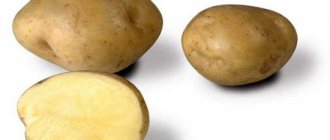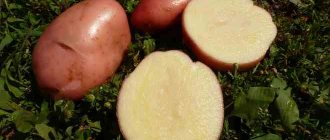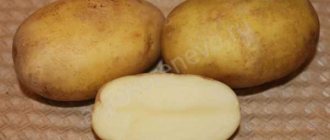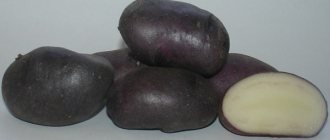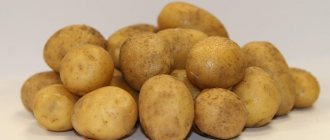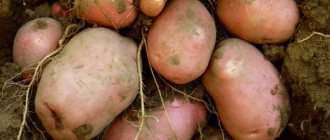Characteristics of the variety
Potatoes of this variety are characterized by the formation of oval or elongated oval, aligned tubers. Potato peel and pulp are light yellow, closer to beige, in color. The eyes are superficial. The taste is excellent.
The description of the variety states the presence of high resistance to damage by the golden potato nematode. Among other things, the value of the Ausonia variety lies in the high yield of marketable tubers for universal use. The variety belongs to the category of being in demand for sale and forms a harvest in a very early period.
Description and characteristics of the variety
Ausonia potato is an early variety. It is grown throughout Russia, Ukraine, Belarus, and Moldova. The variety is resistant to stress, temperature changes, and has high immunity to the golden nematode. Potatoes are suitable for commercial production.
The bush is tall and powerful. It produces an average of 10-12 medium-sized tubers (from 80 to 150 g). Root vegetables are round-oval or slightly elongated. The skin is pale yellow, the flesh is also slightly yellowish or creamy. According to gardeners, the fruits contain 12-16% starch.
The use of tubers is universal. They become overcooked, but keep their shape and are suitable for frying, stewing, and processing into potato products. The taste is excellent.
Landing rules
There are only three traditional methods of planting potatoes: smooth planting, ridge method and planting seed in trenches. Regardless of which method is used, basic rules should be followed. Mandatory operations for preparing seed potatoes for planting are warming up, germination in the light, sorting and calibration of tubers.
- Of great importance for potato yield is the selection of tubers for planting, which should be of medium size and not show signs of disease or pest damage.
- It is recommended to germinate potatoes not in the dark, but in the light, laying them out in a layer of no more than two tubers, then the resulting light sprouts will be green and as strong as possible.
- To stimulate the appearance of sprouts, as well as speed up the readiness of the material for planting, you should treat the tubers in a solution prepared based on a mixture of ash, microelements and copper sulfate.
- A good result is shown by treating the tubers in a 1% solution of potassium permanganate for 45 minutes, followed by soaking in the Epin-extra solution at the rate of 2 drops per glass of water.
- It is recommended to apply the universal fertilizer for potatoes, nitrophoska, when planting directly into each planting hole at the rate of 1 tbsp. l. per plant.
- Potatoes can be grown in a wide range of soil pH reactions, from 4 to 8, since this plant is a calcium-phobic vegetable crop and tolerates increased soil acidity quite well.
It is recommended to prepare the soil in the autumn in order to re-dig the soil in early spring with the addition of the amount of fertilizer necessary to fully enrich the soil. Potatoes grow and bear fruit very well when grown on light, well-fertilized soils with humus. When planting, you should maintain a distance between plants of 30-35 cm with row spacing of 70 cm, which meets the requirements of agricultural technology for growing potatoes.
Ausonia potato variety. Methods for growing potatoes of the Ausonia variety
The early, very productive Ausonia potato from Agro produces even medium and large tubers with good marketability and is suitable for cultivation in homestead and small farms.
Characteristics of the variety
Potatoes of this variety are characterized by the formation of oval or elongated oval, aligned tubers. Potato peel and pulp are light yellow, closer to beige, in color. The eyes are superficial. The taste is excellent.
The description of the variety states the presence of high resistance to damage by the golden potato nematode. Among other things, the value of the Ausonia variety lies in the high yield of marketable tubers for universal use. The variety belongs to the category of being in demand for sale and forms a harvest in a very early period.
How to grow potatoes under hay (
Planting rules
There are only three traditional methods of planting potatoes: smooth planting, ridge method and planting seed material in trenches. Regardless of which method is used, basic rules should be followed. Mandatory operations for preparing seed potatoes for planting are warming up, germination in the light, sorting and calibration of tubers.
- Of great importance for potato yield is the selection of tubers for planting, which should be of medium size and not show signs of disease or pest damage.
- It is recommended to germinate potatoes not in the dark, but in the light, laying them out in a layer of no more than two tubers, then the resulting light sprouts will be green and as strong as possible.
- To stimulate the appearance of sprouts, as well as speed up the readiness of the material for planting, you should treat the tubers in a solution prepared based on a mixture of ash, microelements and copper sulfate.
- A good result is shown by treating the tubers in a 1% solution of potassium permanganate for 45 minutes, followed by soaking in the Epin-extra solution at the rate of 2 drops per glass of water.
- It is recommended to apply the universal fertilizer for potatoes, nitrophoska, when planting directly into each planting hole at the rate of 1 tbsp. l. per plant.
- Potatoes can be grown in a wide range of soil pH reactions, from 4 to 8, since this plant is a calcium-phobic vegetable crop and tolerates increased soil acidity quite well.
Features of care
It is possible to care for small potato plantings without the use of mechanized equipment. However, in large potato fields it is difficult to manually care for the plant.
- If there are extensive potato plantations, manual weeding takes a lot of time and effort, which requires the use of a walk-behind tractor with a rotary harrow.
- The first weeding followed by shallow loosening should be carried out even before the potatoes emerge.
- Potatoes, as a temperate climate plant, do not place high demands on irrigation measures.
- The plant will need its first watering approximately a week after germination. The average amount of water for each bush is at least 5 liters. In the driest and hottest seasons, irrigation can be carried out either in furrows or by regular sprinkling.
- Most often, rotted manure acts as a highly effective fertilizer for potatoes, the use of which helps to almost double the yield of this vegetable crop.
To feed potatoes, it is allowed to use various forms of nitrogen-containing fertilizers, with the exception of ammonium chloride, which is characterized by a high content of chlorine, which is harmful to this vegetable crop.
- It is customary to hill up potatoes by adding soil directly to the stems of the plant. Such an event should be held at least three times per season. However, it is worth remembering that hilling can significantly increase the evaporative surface of the soil, therefore, in dry conditions and in the absence of regular irrigation measures, it is absolutely impossible to carry out such a procedure on potato plantings.
Ausonia Potatoes
An early, very productive variety-population.
The tubers are medium-sized, oval and elongated oval, the peel and pulp are light yellow, and do not darken after cooking. The eyes are superficial.
The taste is excellent. It is resistant to golden potato nematode.
Variety value: high yield of marketable tubers for early market sales. The purpose is universal.
In dry weather, water the potatoes once every two days, regularly weed and loosen the soil.
You will also need to hill up the potatoes twice during the season.
Planting: Before planting, it is recommended to soak the seeds in water for two days.
Hardening at variable temperatures for 10 days is also effective: at night, soaked seeds in trays are kept in the refrigerator at a temperature of +1C, and during the day - indoors at room temperature.
Seeds begin to be sown in boxes from late March to early April. Fill the boxes with a damp mixture of 1 part soil and 4 parts peat, adding fertilizer. Place the sprouted potato seeds in the ground in rows: 5 cm between seeds and 10 cm between rows. Sprinkle the seeds on top with a 0.5 cm layer of sand, compacting it slightly so that it does not wash off when watering.
Cover the boxes with film or glass and move them to a warm place, perhaps to a film greenhouse. Shoots should appear in a week or two. When you see two true leaves on the seedlings, you will need to plant the seedlings in small plastic cups with drainage holes or in peat pots. Regularly water and weed potato seedlings, and during rooting, feed the plants with ammonium nitrate.
After the frosts end, around the third decade of May, potato seedlings can be planted in open ground. Dig holes 10 cm deep, add 300 g of humus into them and water (half a liter of water per hole). Bury the seedlings into the ground so that a stem with three upper leaves remains on the surface.
To protect young potato seedlings from possible temperature changes, cover the bed with film. It can be removed when the plants get stronger and warm weather sets in.
- Author: Maria Sukhorukikh
Rate this article:
- 5
- 4
- 3
- 2
- 1
(0 votes, average: 0 out of 5)
Share with your friends!
Reviews from potato growers
The early-ripening variety "Ausonia" with very tasty, light yellow-colored pulp is popular among gardeners and potato growers. This variety is in great demand when grown under hay, which allows you to form attractive potato bushes with clean and beautiful tubers.
Gardeners note that the variety is practically not affected by diseases and pests, and carrying out just a couple of preventive treatments allows you to completely forget about problems with the health of the plant. On average, each potato bush produces about 10-12 tubers. Even with insufficiently competent and high-quality care, potatoes of the Ausonia variety allow you to get a good harvest of marketable appearance, which is completely suitable for sale.
Characteristics of the Farmer variety
Potato Farmer forms an upright bush with white flowers. Tops and leaves retain color and freshness longer than the time required for tubers to ripen. Up to fifteen oblong-oval tubers are formed in one nest, weighing on average 90–110 grams. The color of the peel is yellow, the flesh is light yellow. The location of the ocelli is sparse, superficial. The starch content in the pulp is 9–12%. Unlike other early varieties, Farmer's tubers have a pronounced pleasant taste. Potatoes do not boil over and do not stick together. These properties make it very attractive in salads. However, Farmer is used to prepare any dishes: in soups, as a side dish or as an independent dish. The keeping quality of the variety reaches 95% when stored in ventilated areas with temperatures up to +2. According to farmers, at higher temperatures, eyes may germinate, which worsens the taste of the tubers.
Farmer potatoes are not overcooked due to their low starch content
The peculiarities of the Farmer potato include the early uniform formation of tubers. This provides the variety with yields that are higher in regions with warmer climates. On average, the yield reaches 200–230 centners per hectare.
An important advantage of the variety is its resistance to golden cyst nematode and some potato viruses. Although the Farmer is affected by late blight, due to the early ripening of the tubers, this is often avoided. Agronomists recommend cutting off the tops in advance, 3–5 days before digging potatoes. Due to this, the surface layer of soil dries out and the ripening of tubers is accelerated, which prevents late blight. As a result, the taste of potatoes and keeping quality improves.
